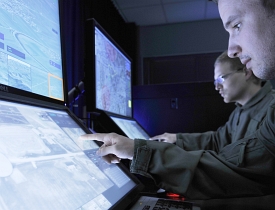 Â NLR is helping the UAS Industry to get ahead
 NLR is helping the UAS Industry to get ahead
Unmanned aircraft are taking to the air more and more often, not only for military applications, but with an increasing demand for civil applications. Unmanned Aerial Systems or UASs perform patrol duties, check for fires, help to determine cadastral borders, enable monitoring for precision farming, inspect oil pipelines, and prove to be valuable in many other application areas. Technological advances are moving ahead rapidly and the industry is eager to get into this niche market. For the UAS industry, i.e. developers, service providers, (potential) end-users and regulatory bodies, all urgently require to obtain their own appropriate level of integrated knowledge of UASs. The National Aerospace Laboratory of the Netherlands (NLR) possesses that knowledge and knows how to provide targeted support and advice. NLR’s new UASLab is ready to boost the UAS knowledge the Laboratory already has and provides the means to experience specific aspects at first hand.
Breeding ground for practical ideas
Last spring NLR unveiled a new facility called the UAS Concept Development & Experience Lab, in short UASLab. The purpose of this creative breeding ground is to converge all the UAS knowledge of NLR, to spawn out-of-the-box ideas and to make people inside and outside the UAS Industry aware of the many aspects of UAS. The centre has adopted a pragmatic approach, covering the application and the development of ‘low hanging’fruit technology on existing platforms, from large to micro UAS. The development of technology is being done in close cooperation with universities and institutes of higher education. As an example, students are developing dampening mechanisms to reduce vibrations for the electronics, develop new landing gears with integrated means to easily switch sensors, and work on algorithms to follow linear structures in the landscape such as dikes and highways. As an example for the practical approach taken; mini-UAS are flying through the lab following a rope on the floor to test the new technology. Another project is aimed at locating people who call for help. In NLR’s in-house unmanned platform, called the ‘Quadrocopter’, researchers have installed sensitive noise sensors capable of detecting, localising and identifying very weak noise signals from UAS.
 User-friendly interfaces
User-friendly interfaces
The laboratory staffers are endeavouring quickly to come up with smart and new functionalities for platforms already purchasable in the high street. Besides this rapid prototyping there is training in the air. Future users employ a simulator to fly a course with the objective of avoiding all kinds of obstacles. It is no easy task with the present cumbersome control equipment that comes mainly from the world of model aircraft. Operators can only start working with real platforms after practising for many hours in the UASLab. So nobody will be surprised to hear that the development of user-friendly interfaces is one of the spearheads of the programme. Together with the Dutch national police force, NLR has developed a user interface for the easy entry of the route, altitude, speed and camera position prior to a mission. A 3D map helps the user to localise his platform and the target. With one press of a button, the user can then launch the platform, even remotely.
Safety first
In the field of airworthiness requirements and regulations there are a number of challenges to be addressed preceding a breakthrough for a broad application of UASs. Just like manned aviation a century ago, unmanned aviation finds itself on the eve of a breakthrough. Users like the armed forces, police and fire brigade are very eager to integrate UASs in their operational systems. The advantages are self-evident: a UAS is cheaper than a manned platform, can be deployed faster and is usable for missions over enemy territory without endangering a pilot. You can also increase the safety of your personnel. In 2011 the regional fire brigade conducted fire-fighting experiments with a UAS. This project, called Firefly, was supervised by NLR and demonstrated the capability of UAS to provide a faster overall picture of the development of the heart of a fire. It can be accomplished without having to deploy fire-fighters or expose them to potential danger. However, users and manufacturers remain hesitant to step into the unmanned flying era in a big way. To some extent this is due to the residual technical imperfections of the systems. But airspace integration and regulation pose an even bigger obstacle. This applies particularly to civil airspace, where UAS must establish a place for itself in the overcrowded skies without endangering other manned or unmanned platforms. It is therefore essential to lay down requirements for airworthiness and rules for flying with UASs.
 Knowledge of certification and airworthines
Knowledge of certification and airworthines
NLR operates at the cutting edge of technology when it comes to knowledge of ‘certification and airworthiness’ in general and ‘sense-and-avoid’ in particular. NLR has a broad experience in the certification of systems that take the air. Just as cars capable of navigating autonomously were recently introduced, we will see within the coming decade the lift-off of UASs that can navigate their way autonomously and safely through the skies. But a flight plan will still be necessary: like pilots sitting in a cockpit, the UAS operators must prepare a flight plan and file it with authorities like air traffic control. The area of certification and airworthiness is another field for which NLR provides training and advises UAS developers, users and aviation authorities.
Advising both users and authorities
NLR’s chain-wide UAS knowledge combined with its impartial and independent status make the organisation a valued adviser for users and authorities alike. Among other things NLR is supporting the armed forces in procuring UASs, translating operational requirements into system requirements and then advising on the type of platform they can best purchase. NLR also answers questions from defence users like: how can you integrate UASs in the command structure? How do you translate data obtained from cameras into useful information? How do you ensure that the information reaches the right place and right person on time? How do you stop a data link from failing and what should you do if it happens anyway? How can you most efficiently couple the data from UASs to other data, or to put it another way, how do you make everything come together to deliver the fullest possible and most reliable total operational picture? And last but not least, how do you ensure that a remote pilot maintains sufficient control over the mission without making mistakes?
Remaining at the forefront
For the time being airworthiness requirements and regulations preclude the large-scale introduction of UAS. There is also room for improvement in the cooperation between the various parties involved. NLR can obviously play a significant role in bringing together parties and knowledge and is an indispensable link in the chain of authorities, users, manufacturers and universities. NLR devises new functionalities, provides training, issues certificates and advises on regulation , in short, the organisation operates across the entire UAS domain with a total picture of what is going on. Amidst the rapid technological advances, however, NLR must keep its integrated UAS knowledge up to date. UASLab is an important first step in that direction, but by no means the end of the road. NLR has set up a training centre for UAS operators in the recently opened Gate-2 centre in the province of Brabant, the Netherlands. It has also established a UAS test facility at Woensdrecht.
NLR’s permanent focus on the development of UAS knowledge stems from its conviction that UASs are about to become extremely popular. By leveraging its applied knowledge and state-of-the-art facilities, NLR is set to play a big role in this unfolding field.
NLR will be present at the AUVSI-Las Vegas 2012, stand 3339

